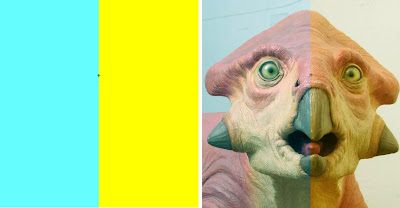
Now stare for 20 seconds at the little “+” on the line between the color fields on the left. (Click on the whole image to make it bigger.)
When you look back at the "+" on the nose of Bix, the color distortions disappear and Bix looks normal, at least for a while.
This is a demonstration of chromatic adaptation, our visual system’s “white balance” control. Whenever the illumination changes in color temperature around us, the sensitivity of our color receptors changes in relative proportion, resulting in a balanced impression of color.







10 comments:
One of my favorite examples of this is looking at house light from the inside and outside at night. When you're inside and the lights are on, everything appears to be a normal natural color. When you step outside at night and look in, the light has a distinct orange cast. (er...this experiment should be conducted on your own home or during a stroll with your dog..)
What a great demonstration!
By the way, my wife bought me your book with the green guy on the cover for christmas - I can't believe what a great job you've done! Wish I had this book before shelling out money to go to art center for a couple terms! Would have saved me thousands of dollars! :) But I am humbly learning quite a bit - especially love the bit about the windmill effect. I keep looking for evidence of it in each image I've done and will use it more purposely from here on out! A much more reliable guide to creating focal interest than your standard contrast!
That's crazy!
That really works! I love these demonstrations of how the visual system works. We've enjoyed the similar demonstrations in your book, Color and Light.
I get a temporary yellow cast on the left, cyan on the right, with a narrow lavender stripe down the center.
Awesome. I love illustrative mind tricks.
That's a very cool optical illusion.
Not exactly related to this phenomenon, but I witnessed an interesting thing a few days ago in a light show on a music stage. As part of the lighting rig, there were long lamps which had a pattern of red, green and blue LEDs on them, which could be swiched on and off in any combination. of course, when all three colours were switched on at the same time, something close to white light was the result. But the really cool thing was when one of these lamps were behind a white curtain, shining through it. When all three RGB colours were mixed in the white cloth, the result was a jumble of cyan, magenta and yellow spots! I thought that was neat.
That's too weird!
So, if you maintain temp. of the light you use throughout a painting, the colors are more likely to read right. Right?
Post a Comment